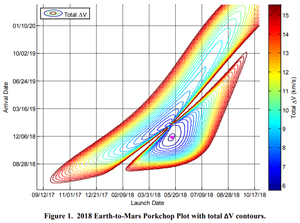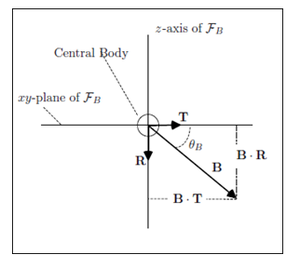Difference between revisions of "Earth-Mars Transfer Trajectory"
(work in progress) |
(adding launch period section) |
||
| Line 1: | Line 1: | ||
| − | + | [[Image: InSight Trajectory.jpg|thumb|right|px|Earth-Mars transfer trajectory of NASA's InSight lander, including planned trajectory correction maneuvers (TCMs)]] | |
| − | + | An Earth-Mars transfer trajectory is an orbital path which a spacecraft follows to travel between Earth and Mars. Several types of trajectories have been studied, but all will satisfy the following conditions: | |
| − | * The starting point must | + | * The starting point must be near the Earth in its orbit around the sun |
* The ending point must intersect Mars in its orbit around the sun | * The ending point must intersect Mars in its orbit around the sun | ||
* The intervening trajectory must be heliocentric, though one or more gravitational swing-bys of other bodies are allowed | * The intervening trajectory must be heliocentric, though one or more gravitational swing-bys of other bodies are allowed | ||
| + | Not all Mars transfer orbits are Hohmann transfers. This is due to the difference in the plane of Earth and Mars's orbit, and can also be due to constraints on launch windows. | ||
There are many variations on this theme, such as whether the spacecraft ends in a Mars-centered orbit or if the spacecraft directly enters the atmosphere from the heliocentric transfer orbit. Other less common variations include the starting orbit at Earth, which could be a low Earth orbit or could instead the mission could begin from geostationary transfer orbit (GTO) as in the MEGA proposals of the late 90's, or one could vary the heliocentric portion of the flight to include a low-thrust trajectory. | There are many variations on this theme, such as whether the spacecraft ends in a Mars-centered orbit or if the spacecraft directly enters the atmosphere from the heliocentric transfer orbit. Other less common variations include the starting orbit at Earth, which could be a low Earth orbit or could instead the mission could begin from geostationary transfer orbit (GTO) as in the MEGA proposals of the late 90's, or one could vary the heliocentric portion of the flight to include a low-thrust trajectory. | ||
| + | |||
| + | |||
| + | [[Image: Porkchopplot.png|thumb|left|px|Porkchop plot for 2018 launch opportunity <ref>https://trs.jpl.nasa.gov/bitstream/handle/2014/44336/13-0679_A1b.pdf?sequence=1</ref>]] | ||
| + | |||
| + | ==Launch Period== | ||
| + | |||
| + | A launch period is a span of days during which a launch vehicle can place the spacecraft in the desired Earth-Mars transfer orbit. A launch '''period''' is different from a launch '''window''' which is a specific time that a launch can take place on a particular day in the launch period. There are many launch windows in a launch period. Sometimes the phrase '''launch opportunity''' is used to refer to the specific year in which a launch period takes place. | ||
| + | |||
| + | Launch periods are generally constrained by the power of the launch vehicle whereas launch windows are also constrained by launch geometry. One way to visualize an acceptable launch period for various values of delta-v is a porkchop plot, which plots contours of constant delta-V on top of launch dates and landing dates. Pick a value of delta-V, and then use that contour to determine the launch period by observing the earliest launch date and latest launch date. | ||
| + | |||
| + | The gap in the porkchop plot is caused by non-planar delta-v in the transfer burns. Since the Earth and Mars orbit in slightly different planes, the most expensive time to launch is when the earth and Mars are at points where their planes are separated by the maximum amount. Conversely, the cheapest time to launch is when their planes intersect. | ||
| + | |||
| + | One drawback of porkchop plots is that they are only for single-arc transfers, which is why they have such large gaps as a result of launch and arrival plane changes. A different transfer trajectory could be constructed which uses a mid-course plane change maneuver at the intersection of the Earth and Mars orbital planes. However, most launch vehicles would not offer this capability. | ||
| + | |||
| + | |||
| + | |||
| + | [[Image: B Plane Targeting.png|thumb|left|px|B Plane used for targeting trajectory correction maneuvers]] | ||
==Targeting== | ==Targeting== | ||
| − | I'm not sure what is used for targeting the initial transfer orbit insertion burn, but the trajectory correction maneuver burns target a point on the "B-plane" of Mars. The B-plane is defined | + | I'm not sure what is used for targeting the initial transfer orbit insertion burn, but the trajectory correction maneuver burns target a point on the "B-plane" of Mars. The B-plane is defined in a JPL glossary as the "plane perpendicular to the asymptote of the incoming hyperbolic trajectory of the object relative to the Earth."<ref>https://cneos.jpl.nasa.gov/glossary/b_plane.html</ref> I think of it as the "bullseye" plane, which is the plane of the dartboard from the perspective of the person throwing darts. B-plane targeting was originally developed for gravity-assist maneuvers, but it has come to be used for missions where the destination is the planet itself as well. |
| − | |||
==topics to elaborate on== | ==topics to elaborate on== | ||
* opposition vs conjunction class transfers | * opposition vs conjunction class transfers | ||
| − | |||
| − | |||
| − | |||
* plane changes | * plane changes | ||
* low-thrust trajectories | * low-thrust trajectories | ||
| Line 28: | Line 42: | ||
==References== | ==References== | ||
| + | |||
| + | * https://blog.adafruit.com/2018/07/26/how-porkchop-plots-determine-earth-to-mars-trajectories-nasa/ | ||
| + | * https://trs.jpl.nasa.gov/bitstream/handle/2014/44336/13-0679_A1b.pdf?sequence=1 Ryan C. Woolley and Charles W. Whetsel "On the nature of Earth-Mars porkchop plots" 2014 AAS | ||
Revision as of 16:30, 8 October 2018
An Earth-Mars transfer trajectory is an orbital path which a spacecraft follows to travel between Earth and Mars. Several types of trajectories have been studied, but all will satisfy the following conditions:
- The starting point must be near the Earth in its orbit around the sun
- The ending point must intersect Mars in its orbit around the sun
- The intervening trajectory must be heliocentric, though one or more gravitational swing-bys of other bodies are allowed
Not all Mars transfer orbits are Hohmann transfers. This is due to the difference in the plane of Earth and Mars's orbit, and can also be due to constraints on launch windows. There are many variations on this theme, such as whether the spacecraft ends in a Mars-centered orbit or if the spacecraft directly enters the atmosphere from the heliocentric transfer orbit. Other less common variations include the starting orbit at Earth, which could be a low Earth orbit or could instead the mission could begin from geostationary transfer orbit (GTO) as in the MEGA proposals of the late 90's, or one could vary the heliocentric portion of the flight to include a low-thrust trajectory.

Launch Period
A launch period is a span of days during which a launch vehicle can place the spacecraft in the desired Earth-Mars transfer orbit. A launch period is different from a launch window which is a specific time that a launch can take place on a particular day in the launch period. There are many launch windows in a launch period. Sometimes the phrase launch opportunity is used to refer to the specific year in which a launch period takes place.
Launch periods are generally constrained by the power of the launch vehicle whereas launch windows are also constrained by launch geometry. One way to visualize an acceptable launch period for various values of delta-v is a porkchop plot, which plots contours of constant delta-V on top of launch dates and landing dates. Pick a value of delta-V, and then use that contour to determine the launch period by observing the earliest launch date and latest launch date.
The gap in the porkchop plot is caused by non-planar delta-v in the transfer burns. Since the Earth and Mars orbit in slightly different planes, the most expensive time to launch is when the earth and Mars are at points where their planes are separated by the maximum amount. Conversely, the cheapest time to launch is when their planes intersect.
One drawback of porkchop plots is that they are only for single-arc transfers, which is why they have such large gaps as a result of launch and arrival plane changes. A different transfer trajectory could be constructed which uses a mid-course plane change maneuver at the intersection of the Earth and Mars orbital planes. However, most launch vehicles would not offer this capability.
Targeting
I'm not sure what is used for targeting the initial transfer orbit insertion burn, but the trajectory correction maneuver burns target a point on the "B-plane" of Mars. The B-plane is defined in a JPL glossary as the "plane perpendicular to the asymptote of the incoming hyperbolic trajectory of the object relative to the Earth."[2] I think of it as the "bullseye" plane, which is the plane of the dartboard from the perspective of the person throwing darts. B-plane targeting was originally developed for gravity-assist maneuvers, but it has come to be used for missions where the destination is the planet itself as well.
topics to elaborate on
- opposition vs conjunction class transfers
- plane changes
- low-thrust trajectories
- earth orbit part, launch sites, equatorial vs polar parking orbits (or lack of difference between them)
- GTO to Mars transfer scheme
- mars capture schemes: aerobraking, ballistic capture
References
- https://blog.adafruit.com/2018/07/26/how-porkchop-plots-determine-earth-to-mars-trajectories-nasa/
- https://trs.jpl.nasa.gov/bitstream/handle/2014/44336/13-0679_A1b.pdf?sequence=1 Ryan C. Woolley and Charles W. Whetsel "On the nature of Earth-Mars porkchop plots" 2014 AAS








